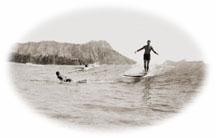

As almost everybody knows the roots of surfing can be found on the islands of Hawaii. Even the first european discoverers admired the art of surfing until the missionaries forbid the sport. Well, this didnīt stop the Hawaiians to continue surfing.
The boards used till the 19th century were called olo (Longboard), kikoīo, alaia and the bodyboard paipo. The last three mentioned were shorter boards and made from koa-wood or ulu, Longboards (olo) were made from the wood of the wili wili tree that was lighter. Despite this you canīt call an olo not a lightweight board, at a length between 15 and 25 feet they had a weight of aprox. 120 to 190 pound.
The alaia-boards match current boards the most at a lenght of 7 to 12 feet, 18 inch width and a thickness of aprox. 1 1/2 inch.


At the beginning of the 20. century shapers tried to reduce the weight of the boards by experimenting around with hollow surfboards. Here was the biggest problem to get the hollow board waterproof like the later showing up boards made from balsawood.
The Hawaiians, who were the first to use balsawood at the beginning of the 20th century, used coconut oil as a sealing. Later, when balsawood was easier accessible, more and more boards were made from balsawood in Hawaii as well as in California. In some boards redwood was added for more strength.
At the beginning of the 2nd World-War for the first time resin and fiberglas was accessible to seal the boards made from wood.At the same time the new foam types were invented and used for surfboards so that the era of wooden boards ended here.
Despite this balsawood gets more and more popular amongst surfers as riding a board made from wood is an experience that should not be missed out due to the sensational way a wooden board feels in the water.

